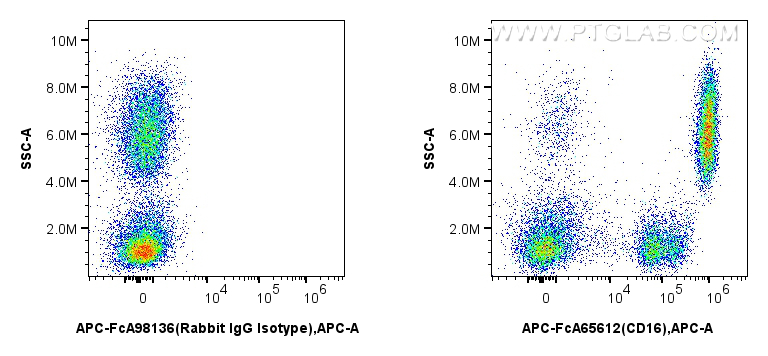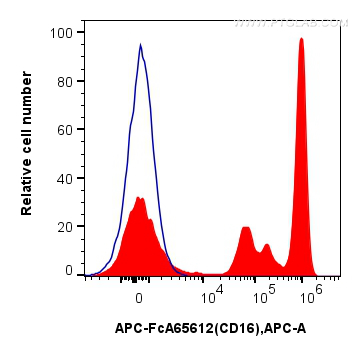验证数据展示
经过测试的应用
| Positive FC detected in | human peripheral blood leukocytes |
推荐稀释比
| 应用 | 推荐稀释比 |
|---|---|
| This reagent has been pre-titrated and tested for flow cytometric analysis. The suggested use of this reagent is 5 ul per 10^6 cells in a 100 µl suspension or 5 ul per 100 µl of whole blood. | |
| Sample-dependent, Check data in validation data gallery. | |
产品信息
APC-FcA65612 targets CD16 in FC applications and shows reactivity with human samples.
| 经测试应用 | FC Application Description |
| 经测试反应性 | human |
| 免疫原 | N/A 种属同源性预测 |
| 宿主/亚型 | Rabbit / IgG |
| 抗体类别 | Recombinant |
| 产品类型 | Antibody |
| 全称 | Fc fragment of IgG, low affinity IIIa, receptor (CD16a) |
| 别名 | Fc gamma RIII alpha, Fc gamma RIII, CD16-II, CD16a antigen, CD16A |
| 计算分子量 | 254 aa, 29 kDa |
| GenBank蛋白编号 | BC017865 |
| 基因名称 | CD16a |
| Gene ID (NCBI) | 2214 |
| ENSEMBL Gene ID | ENSG00000203747 |
| 偶联类型 | APC Fluorescent Dye |
| 最大激发/发射波长 | 650 nm / 660 nm |
| 形式 | Liquid |
| 纯化方式 | Protein A purification |
| 储存缓冲液 | PBS with 0.09% sodium azide and 0.5% BSA , pH 7.3 |
| 储存条件 | Store at 2-8°C. Avoid exposure to light. Stable for one year after shipment. |
背景介绍
CD16 is a 50-70-kDa low affinity Fc receptor found on the surface of natural killer cells, neutrophil polymorphonuclear leukocytes, monocytes and macrophages. CD16 mediates antibody-dependent cellular cytotoxicity (ADCC) and other antibody-dependent responses, such as phagocytosis. CD16 has been identified as Fc receptors FcγRIIIa (CD16a) and FcγRIIIb (CD16b), encoded by two nearly identical genes, FCGR3A and the FCGR3B. Clone 3G8 recognizes both the CD16a and CD16b (PMID: 7592758).
实验方案
| Product Specific Protocols | |
|---|---|
| FC protocol for APC CD16 antibody APC-FcA65612 | Download protocol |
| Standard Protocols | |
|---|---|
| Click here to view our Standard Protocols |

